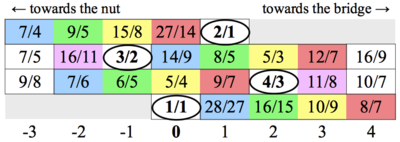Kite's thoughts on the mathematical basis For the kite guitar
Consider this sequence: 9/8 -- 7/6 -- 6/5 -- 5/4 -- 9/7 -- 4/3. These are sequential intervals on one string of the Kite Guitar, and this is the essence of what makes it so playable. 1/1 must of course be on the next string down, to make each of these ratios available to play as an interval. Since 6/5 and 5/4 add up to 3/2, we know that 3/2 is on the next string up. And 3/2 plus 4/3 is 2/1, thus 2/1 is on the next string up after 3/2. From this we can derive the entire layout. The next chart shows the downmajor tuning, but this analysis also applies to the upminor and upmajor tunings.

What if this sequence from 9/8 to 4/3 was all we knew of the guitar? Could we deduce that it is in 41-edo? No, but we can work backwards from the notes to deduce what commas are being tempered out. From 9/8 to 6/5 = 16/15 = 2 frets. From 6/5 to 5/4 = 25/24 = 1 fret. Thus (25/24)^2 = 16/15, which gives us the Laquinyo or Magic comma. This comma is the difference between (5/4)^5 and 3/1, thus its pergen is #37, (P8, P12/5).
This temperament can be extended to prime limit 7 and 11. 9/8 to 7/6 = 28/27 = 1 fret. 6/5 to 5/4 = 25/24 = 1 fret. Thus 28/27 = 25/24, which gives us the Ruyoyo comma 225/224. Extending the sequence of ratios increases the prime limit to 11: 9/8 -- 7/6 -- 6/5 -- 5/4 -- 9/7 -- 4/3 -- 11/8. From 4/3 to 11/8 = 33/32 = 1 fret. Since 25/25 is also 1 fret, 33/32 = 25/24, which implies the Luyoyo comma. Tempering out Laquinyo and Ruyoyo and Luyoyo gives us 11-limit Laquinyo/Magic. These are both strong extensions, i.e. the pergen doesn't change.
This pergen is easily notated with a single additional pair of accidentals. From the pergen guide, which assumes that the fifth is tuned to 700 + c cents, where c is a free variable:
Period = P8 = 1200¢, Generator = vM3 = ^4dd4 = 380¢ + c/5, Enharmonic = ^5dd2 = 0¢, ^5C = B##, and ^ = 20¢ + 3.8c
This table, also from the notation guide, shows a 20-step section of the pergen's genchain. The first row shows the cents of each interval from the tonic, the second shows the interval name, and the third shows the note names in the key of D.
| 1000¢
-2c |
180¢
-1.8c |
560¢
-1.6c |
940¢
-1.4c |
120¢
-1.2c |
500¢
-c |
880¢
-0.8c |
60¢
-0.6c |
440¢
-0.4c |
820¢
-0.2c |
0¢ | 380¢
+0.2c |
760¢
+0.4c |
1140¢
+0.6c |
320¢
+0.8c |
700¢
+c |
1080
+1.2c |
260¢
+1.4c |
640¢
+1.6c |
1020
+1.8c |
200¢
+2c |
| m7 | vM2 | vvA4 | ^^d7 | ^m2 | P4 | vM6 | vvA1 | ^^d4 | ^m6 | P1 | vM3 | vvA5 | ^^d8 | ^m3 | P5 | vM7 | vvA2 | ^^d5 | ^m7 | M2 |
| C | vE | vvG# | ^^Cb | ^Eb | G | vB | vvD# | ^^Gb | ^Bb | D | vF# | vvA# | ^^Db | ^F | A | vC# | vvE# | ^^Ab | ^C | E |
Extrapolating fourthwards, 32/27 is 300¢ - 3c, and 32/27 = from 9/8 to 4/3 = 5 frets. Thus 1 fret = 60¢ - 0.6c. Assuming a downmajor tuning, the adjacent-open-string-interval is 380¢ + 0.2c. The fretboard looks like this:
| 0 | 1 | 2 | 3 | 4 | ||||
|---|---|---|---|---|---|---|---|---|
| P8+700+c | P8+760+0.4c | |||||||
| P8+320+0.8c | P8+380+0.2c | |||||||
| 1140+0.6c | 1200 (P8) | |||||||
| 760+0.4c | 820-0.2c | |||||||
| 380+0.2c | 440-0.4c | |||||||
| 0 | 60-0.6c |
Now c can be anything, and many values won't give you any edo at all. But certain values of c result in 19, 22, or 41 edo. 19edo and 22edo guitars can mimic Kite guitars if the open strings are tuned in 3rds.
41 arises from doubling 19 and 22 and looking at every 3rd edo: 38-41-44. Or you can triple 19 & 22 and take every 3rd edo. 57-60-63-66. So 60 and 63 are also possibilities. Instead of every other fret of 41, it would be every 3rd fret of 57 or 60.
So for 19 and 22, we have every fret of the edo, for 41 we have every other fret, and for 60 and 63 we have every 3rd fret.
For 19, 22, 41, 60, etc., the ratios within the immediate area of 1/1 are all the same, except for how well tuned they are. But the ratios up the neck are quite different. With 41, 12 frets up 1 string make 3/2. But in 19, 3/2 is 11 frets. In 22, it's 13 frets. In 41, the octave is up 1 string and up 14 frets, which I write as (+1,+14). In 19, its (+1,+13), and in 22, it's (+1, +15). But in a non-edo tuning of Laquinyo/Magic, the 8ve doesn't appear anywhere up the neck.
This is a huge disadvantage to a non-edo Kite guitar, because when two guitarists play together, with a 41-edo tuning, one guitarist can solo 14 frets above the other.